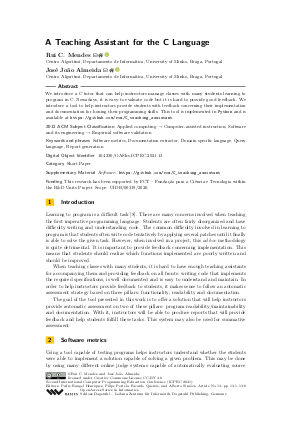A Teaching Assistant for the C Language (Short Paper)
Authors
Rui C. Mendes  ,
José João Almeida
,
José João Almeida 
-
Part of:
Volume:
Second International Computer Programming Education Conference (ICPEC 2021)
Part of: Series: Open Access Series in Informatics (OASIcs)
Part of: Conference: International Computer Programming Education Conference (ICPEC) - License:
 Creative Commons Attribution 4.0 International license
Creative Commons Attribution 4.0 International license
- Publication Date: 2021-07-01
File

PDF
OASIcs.ICPEC.2021.13.pdf
- Filesize: 0.49 MB
- 8 pages
Document Identifiers
Subject Classification
ACM Subject Classification
- Applied computing → Computer-assisted instruction
- Software and its engineering → Empirical software validation
Keywords
- Software metrics
- Documentation extractor
- Domain specific language
- Query language
- Report generation
Metrics
- Access Statistics
-
Total Accesses (updated on a weekly basis)
0PDF Downloads0Metadata Views
Abstract
We introduce a C tutor that can help instructors manage classes with many students learning to program in C. Nowadays, it is easy to evaluate code but it is hard to provide good feedback. We introduce a tool to help instructors provide students with feedback concerning their implementation and documentation for honing their programming skills. This tool is implemented in Python and is available at https://github.com/rcm/C_teaching_assistant.
Cite As Get BibTex
Rui C. Mendes and José João Almeida. A Teaching Assistant for the C Language (Short Paper). In Second International Computer Programming Education Conference (ICPEC 2021). Open Access Series in Informatics (OASIcs), Volume 91, pp. 13:1-13:8, Schloss Dagstuhl – Leibniz-Zentrum für Informatik (2021)
https://doi.org/10.4230/OASIcs.ICPEC.2021.13
BibTex
@InProceedings{mendes_et_al:OASIcs.ICPEC.2021.13,
author = {Mendes, Rui C. and Almeida, Jos\'{e} Jo\~{a}o},
title = {{A Teaching Assistant for the C Language}},
booktitle = {Second International Computer Programming Education Conference (ICPEC 2021)},
pages = {13:1--13:8},
series = {Open Access Series in Informatics (OASIcs)},
ISBN = {978-3-95977-194-8},
ISSN = {2190-6807},
year = {2021},
volume = {91},
editor = {Henriques, Pedro Rangel and Portela, Filipe and Queir\'{o}s, Ricardo and Sim\~{o}es, Alberto},
publisher = {Schloss Dagstuhl -- Leibniz-Zentrum f{\"u}r Informatik},
address = {Dagstuhl, Germany},
URL = {https://drops.dagstuhl.de/entities/document/10.4230/OASIcs.ICPEC.2021.13},
URN = {urn:nbn:de:0030-drops-142296},
doi = {10.4230/OASIcs.ICPEC.2021.13},
annote = {Keywords: Software metrics, Documentation extractor, Domain specific language, Query language, Report generation}
}
Author Details
Funding
This research has been supported by FCT - Fundação para a Ciência e Tecnologia within the R&D Units Project Scope: UIDB/00319/2020.
Supplementary Materials
References
- Sergey Astanin. Tabulate. https://pypi.org/project/tabulate/. Accessed: 2021-04-09.
-
Rachel Cardell-Oliver. How can software metrics help novice programmers? In Proceedings of the Thirteenth Australasian Computing Education Conference-Volume 114, pages 55-62, 2011.

-
Don Coleman, Dan Ash, Bruce Lowther, and Paul Oman. Using metrics to evaluate software system maintainability. Computer, 27(8):44-49, 1994.

-
Francisco Jurado, Miguel A Redondo, and Manuel Ortega. Using fuzzy logic applied to software metrics and test cases to assess programming assignments and give advice. Journal of Network and Computer Applications, 35(2):695-712, 2012.

-
Nadia Kasto and Jacqueline Whalley. Measuring the difficulty of code comprehension tasks using software metrics. In Proceedings of the Fifteenth Australasian Computing Education Conference-Volume 136, pages 59-65, 2013.

- Xavier Marcelet. Coverxygen. https://pypi.org/project/coverxygen/. Accessed: 2021-04-09.
- Thomas J McCabe. A complexity measure. IEEE Transactions on software Engineering, SE-2(4):308-320, 1976. URL: https://doi.org/10.1109/TSE.1976.233837.
- Simon, Andrew Luxton-Reilly, Vangel V. Ajanovski, Eric Fouh, Christabel Gonsalvez, Juho Leinonen, Jack Parkinson, Matthew Poole, and Neena Thota. Pass rates in introductory programming and in other stem disciplines. In Proceedings of the Working Group Reports on Innovation and Technology in Computer Science Education, ITiCSE-WGR '19, page 53–71, New York, NY, USA, 2019. Association for Computing Machinery. URL: https://doi.org/10.1145/3344429.3372502.
-
Errol Thompson, Andrew Luxton-Reilly, Jacqueline L Whalley, Minjie Hu, and Phil Robbins. Bloom’s taxonomy for cs assessment. In Proceedings of the tenth conference on Australasian computing education-Volume 78, pages 155-161, 2008.

-
Szymon Wasik, Maciej Antczak, Jan Badura, Artur Laskowski, and Tomasz Sternal. A survey on online judge systems and their applications. ACM Computing Surveys (CSUR), 51(1):1-34, 2018.

- Konrad Weihmann. Multimetric. https://pypi.org/project/multimetric/. Accessed: 2021-04-09.
